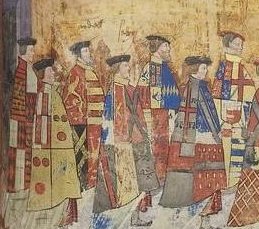On 23 April 1536, the annual meeting of the Order of the Garter took place at Greenwich attended by the King and many Lords. It was expected that George Boleyn would be preferred but instead Henry chose Sir Nicholas Carew, ‘Anne’s known enemy and the man who had been mentoring Jane Seymour’ (Weir, pg. 88).
The entry from Letters & Papers reads,
On St. George’s Day, 23 April 28 Hen. VIII., a chapter of the Order of the Garter was held at Greenwich, at which were present the King, the dukes of Richmond and Norfolk, the earls of Northumberland, Westmoreland, Wiltshire, Sussex, Rutland, and Oxford, lord Sandys, and Sir Wm. Fitzwilliam. It was determined to hold the feast on May 21, the earl of Northumberland taking the Sovereign’s place, assisted by the earls of Rutland, Westmoreland, and Oxford, and Sir Wm. Fitzwilliam. Votes were taken for the election of a knight; and the next day, after mass for the dead, the King declared Sir Nic. Carew elected. He was installed when the feast was kept, on May 21. On this occasion the earl of Northumberland was seized with vertigo and weakness, so that it was feared he would not be able to take his part as deputy, but he recovered. The next day the hatchments of the deceased were offered up.
On April 29, Chapuys wrote to Charles V,
The Grand Ecuyer, Mr. Caro, had on St. George’s day the Order of the Garter in the place of the deceased M. de Burgain (lord Abergavenny), to the great disappointment of Rochford, who was seeking for it, and all the more because the Concubine has not had sufficient influence to get it for her brother; and it will not be the fault of the said Ecuyer if the Concubine, although his cousin (quelque, qu. quoique? cousine) be not dismounted. He continually counsels Mrs. Semel and other conspirators “pour luy faire une venue,” and only four days ago he and some persons of the chamber sent to tell the Princess to be of good cheer, for shortly the opposite party would put water in their wine, for the King was already as sick and tired of the concubine as could be; and the brother of lord Montague told me yesterday at dinner that the day before the bishop of London had been asked if the King could abandon the said concubine, and he would not give any opinion to anyone but the King himself, and before doing so he would like to know the King’s own inclination, meaning to intimate that the King might leave the said concubine, but that, knowing his fickleness, he would not put himself in danger. The said Bishop was the principal cause and instrument of the first divorce, of which he heartily repents, and would still more gladly promote this, the said concubine and all her race are such abominable Lutherans. London, 29 April 1536.
Some ominous signs for Anne and the Boleyn faction but as Weir points out in The Lady in the Tower: The Fall of Anne Boleyn, five days later, on April 28, Henry Lord Stafford wrote to the Earl of Westmoreland to thank him for ‘furthering my suit with the Queen.’ Although Chapuys believed that Anne was falling from favour, clearly others still felt her influence intact.
SourcesWeir, A. The Lady in the Tower: The Fall of Anne Boleyn, 2009.
‘Henry VIII: April 1536, 21-25’, Letters and Papers, Foreign and Domestic, Henry VIII, Volume 10: January-June 1536 (1887), pp. 287-310. URL: http://www.british-history.ac.uk/report.aspx?compid=75427 Date accessed: 23 April 2012.
‘Henry VIII: April 1536, 26-30’, Letters and Papers, Foreign and Domestic, Henry VIII, Volume 10: January-June 1536 (1887), pp. 310-329. URL: http://www.british-history.ac.uk/report.aspx?compid=75428 Date accessed: 23 April 2012.
















Latest Comments